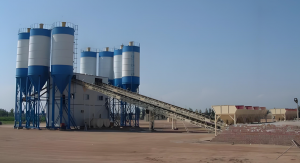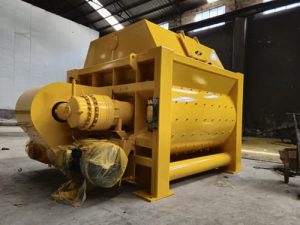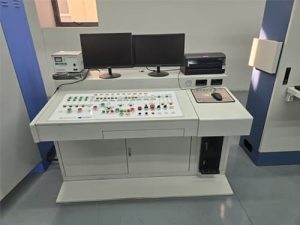Relative News
Products
Structure of JS750 concrete mixer
The JS750 concrete mixer is usually composed of parts such as the mixing system, transmission system, feeding system, discharging system, water supply system, and electrical control system.
Mixing system: It is the core part, mainly including the mixing drum and mixing blades. The JS750 concrete mixer is generally a twin-shaft forced mixer.
The mixing blades are installed on the mixing shaft. Driven by the mixing shaft, they vigorously stir the materials to fully mix all kinds of materials.
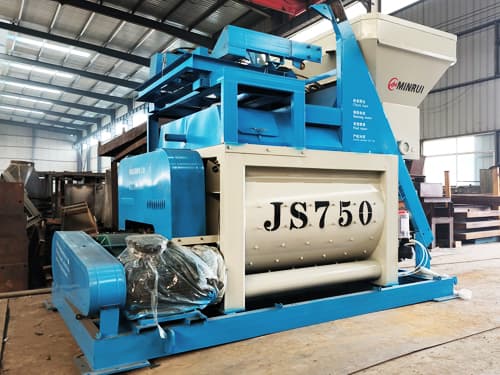



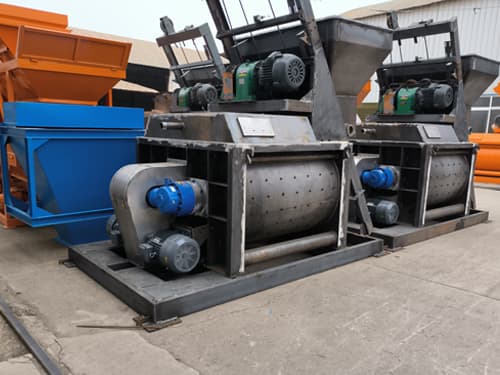
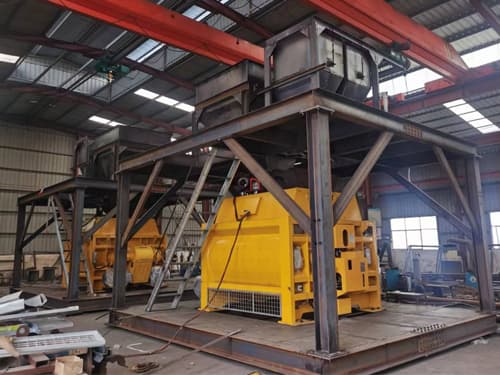
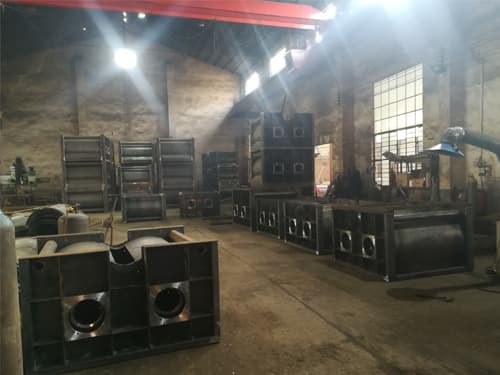
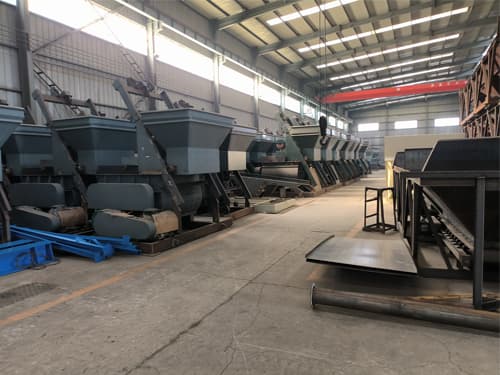
JS750 concrete mixer is generally a twin – shaft forced mixer. The mixing blades are mounted on the mixing shaft. Driven by the mixing shaft, they stir the materials vigorously to ensure thorough mixing of all materials. Its feeding capacity is generally 1200L and the discharging capacity is 750L. JS750 concrete mixer can mix dry, plastic, flowing concrete, lightweight aggregate concrete and various mortars.
Transmission system: It consists of an electric motor, a reducer, transmission gears, etc., which provides power for the mixer and transmits the power to various working parts. For example, the electric motor provides the initial power, the reducer adjusts the rotational speed to an appropriate range, and then the transmission gears drive parts such as the mixing shaft to operate.
Feeding system: It includes a feeding hopper, wire ropes, track pulleys, etc., and is used to lift the materials into the mixing drum. The feeding hopper moves on the track pulleys via the wire ropes to achieve the feeding function.
Discharging system: It mainly consists of a discharging door, which is used to discharge the mixed concrete from the mixing drum. The sealing and flexibility of the discharging door are very important for the normal operation of the equipment. It is necessary to prevent material leakage and jamming.
Water supply system: Generally includes a water distribution system, water meter, three – way valve, etc., and is used to accurately supply the required amount of water to the mixing drum.
Electrical control system: Controls operations such as starting, stopping, forward and reverse rotation of the mixer to ensure the normal operation of the equipment. It is usually equipped with safety devices such as secondary leakage protection to ensure the safety of operators.
Maintenance of JS750 Concrete Mixer
Daily maintenance
Cleaning and Inspection: Keep the body of the JS750 concrete mixer clean. Remove dirt and obstacles on the body in a timely manner to prevent them from affecting the normal operation of the equipment or damaging its components.
Check the oil in lubrication points, circuits, and control devices. Add lubricating oil as required to ensure good lubrication and power supply for all parts of the equipment. At the same time, make sure the JS750 concrete mixer is placed on a flat surface. Use square timbers to prop up the front and rear axles so that the tires are elevated off the ground to avoid movement when the blender is in operation.
Pre-start inspection: Check whether the JS750 concrete mixer blades are bent and whether the screws are loose or knocked off. If there are any abnormalities, they should be handled in a timely manner. Check whether the transmission clutch and brake are flexible and reliable, whether the wire ropes are damaged, whether the track pulleys are in good condition, whether there are any obstacles around, and the lubrication conditions of each part. Add water to the mixing drum and let it run idle for 1 – 2 minutes. At the same time, check the reliability of the clutch and brake device.
Operation monitoring: During the operation of the JS750 concrete mixer, constantly listen to check if the noises of the motor, reducer, and transmission gears are normal, and if the temperature rise is too high. If there are any abnormalities, stop the machine immediately for inspection.
Cleaning after work: After each shift of work, carefully clean the mixer to remove impurities such as residual concrete, preventing it from solidifying inside the equipment and affecting the next use. When the mixing is completed or when it is expected to stop for more than 1 hour, the remaining materials should be completely discharged, and then pour gravel and clean water into the mixing drum and turn on the machine to rotate for thorough flushing.
Safe operation: The blender should be equipped with second-level leakage protection. After the power is turned on before operation, it is necessary to run the machine idle for a test. It can be used only after confirming that everything is correct. After the work is finished or when the machine is not in use and shut down, the power switch should be turned off and the switch box should be locked to ensure safety.
First-level maintenance
Generally, after the JS750 concrete mixer has been working for a certain period of time (for example, after 100 hours of operation or 5000 cubic meters of mixing volume, which is specifically determined according to the JS750 concrete mixer equipment operation manual), first-level maintenance is required. In addition to the daily maintenance work, the following operations also need to be carried out:
Component disassembly inspection and adjustment: Disassemble and inspect the clutch, check and adjust the brake clearance. If the inner and outer brake bands of the clutch are excessively worn, they must be replaced. Check components such as the wire rope, V – belt, sliding bearings, water distribution system, and traveling wheels, etc. Examine their wear, looseness, or damage conditions and handle them in a timely manner.
Special inspection: Check the sealing and flexibility of the feeding hopper and discharge door to prevent material leakage and jamming. Inspect and tighten all loose screws and connectors, and replenish lubrication at each lubrication point.
Secondary maintenance
After the JS750 concrete mixer has operated for a longer period (for example, after 700 – 1500 hours of operation or 10,000 cubic meters of mixing volume, specifically determined according to the JS750 concrete mixer equipment operation manual), secondary maintenance is required. In addition to performing the primary maintenance work, the following operations also need to be carried out:
Disassembly and inspection of the reducer: When disassembling and inspecting the reducer, clean the gears, shafts, bearings, and oil passages, and check the wear degree of the tooth profile surface. After the disassembly and inspection is completed, add new gear oil and ensure tight sealing to prevent oil leakage.
Maintenance of open gears and replacement of brake bands: Disassemble and inspect the open gears, clean the gear profiles, shafts, and bearings, and check for wear. If there is excessive wear, the parts should be replaced. If the inner and outer brake bands of the feeding clutch are worn excessively, they should be replaced in a timely manner to ensure the reliability and safety of braking.
Rack maintenance: Check whether the rack is skewed or deformed. If so, repair or correct it to ensure the overall structural stability of the equipment.
Inspection of auxiliary components: Disassemble and inspect auxiliary components such as water meters and three – way valves, remove rust and scale, apply anti – rust paint, and keep the waterway unobstructed.
Matters needing attention
The JS750 concrete mixer should be operated by personnel familiar with its structure, performance, and operating procedures. It is strictly prohibited to use the JS750 concrete mixer beyond its rated capacity to avoid causing damage to the machine.
Maintenance work should be carried out by professionals to ensure standardized and safe operations. When disassembling, inspecting, and replacing parts, original factory accessories that meet the equipment requirements should be used to ensure stable equipment performance.
Strictly abide by the equipment usage instructions and safety operating procedures to prevent accidents. When purchasing equipment, it is recommended to go through formal channels to ensure product quality and after-sales service.
